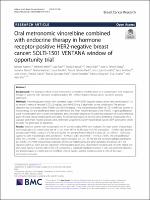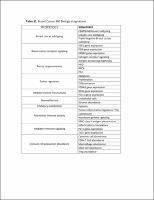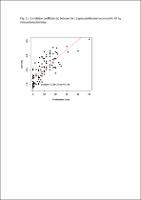| dc.contributor | Vall d'Hebron Barcelona Hospital Campus |
| dc.contributor.author | Adamo, Barbara |
| dc.contributor.author | Pascual, Tomás |
| dc.contributor.author | Vidal, Maria |
| dc.contributor.author | Pérez Fidalgo, José A |
| dc.contributor.author | Gómez Pardo, Patricia |
| dc.contributor.author | Paré, Laia |
| dc.contributor.author | Bellet Ezquerra, Meritxell |
| dc.date.accessioned | 2020-07-08T12:04:08Z |
| dc.date.available | 2020-07-08T12:04:08Z |
| dc.date.issued | 2019-09-18 |
| dc.identifier.citation | Adamo B, Bellet M, Paré L, Pascual T, Vidal M, Pérez Fidalgo JA, et al. Oral metronomic vinorelbine combined with endocrine therapy in hormone receptor-positive HER2-negative breast cancer: SOLTI-1501 VENTANA window of opportunity trial. Breast Cancer Res. 2019 Sep 18;21(1):108. |
| dc.identifier.issn | 1465-542X |
| dc.identifier.uri | https://hdl.handle.net/11351/5073 |
| dc.description | Breast cancer; Metronomic; Vinorelbine |
| dc.description.abstract | Background: The biological effect of oral metronomic vinorelbine (mVNB) alone or in combination with endocrine therapy in patients with hormone receptor-positive (HR+)/HER2-negative breast cancer has been scarcely addressed. Methods: Postmenopausal women with untreated stage I-III HR+/HER2-negative breast cancer were randomized (1:1:1) to receive 3 weeks of letrozole (LTZ) 2.5 mg/day, oral mVNB 50 mg 3 days/week, or the combination. The primary objective was to evaluate, within PAM50 Luminal A/B disease, if the anti-proliferative effect of LTZ+mVNB was superior to monotherapy. An anti-proliferative effect was defined as the mean relative decrease of the PAM50 11-gene proliferation score in combination arm vs. both monotherapy arms. Secondary objectives included the evaluation of a comprehensive panel of breast cancer-related genes and safety. An unplanned analysis of stromal tumor-infiltrating lymphocytes (sTILs) was also performed. PAM50 analyses were performed using the nCounter®-based Breast Cancer 360™ gene panel, which includes 752 genes and 32 signatures. Results: Sixty-one patients were randomized, and 54 paired samples (89%) were analyzed. The main patient characteristics were mean age of 67, mean tumor size of 1.7 cm, mean Ki67 of 14.3%, stage I (55.7%), and grades 1-2 (90%). Most baseline samples were PAM50 Luminal A (74.1%) or B (22.2%). The anti-proliferative effect of 3 weeks of LTZ+mVNB (- 73.2%) was superior to both monotherapy arms combined (- 49.9%; p = 0.001) and mVNB (- 19.1%; p < 0.001). The anti-proliferative effect of LTZ+mVNB (- 73.2%) was numerically higher compared to LTZ (- 65.7%) but did not reach statistical significance (p = 0.328). LTZ+mVNB induced high expression of immune-related genes and gene signatures, including CD8 T cell signature and PDL1 gene and low expression of ER-regulated genes (e.g., progesterone receptor) and cell cycle-related and DNA repair genes. In tumors with ≤ 10% sTILs at baseline, a statistically significant increase in sTILs was observed following LTZ (paired analysis p = 0.049) and LTZ+mVNB (p = 0.012). Grade 3 adverse events occurred in 3.4% of the cases. Conclusions: Short-term mVNB is well-tolerated and presents anti-proliferative activity alone and in combination with LTZ. The high expression of immune-related biological processes and sTILs observed with the combination opens the possibility of studying this combination with immunotherapy. Further investigation comparing these biological results with other metronomic schedules or drug combinations is warranted. |
| dc.language.iso | eng |
| dc.publisher | Springer Nature |
| dc.relation.ispartofseries | Breast Cancer Research;21(1) |
| dc.rights | Attribution 4.0 International |
| dc.rights.uri | http://creativecommons.org/licenses/by/4.0/ |
| dc.source | Scientia |
| dc.subject | Marcadors tumorals |
| dc.subject | Medicaments antineoplàstics |
| dc.subject | Mama - Càncer - Tractament |
| dc.subject.mesh | Breast Neoplasms |
| dc.subject.mesh | Biomarkers, Tumor |
| dc.subject.mesh | Vinorelbine |
| dc.subject.mesh | /drug therapy |
| dc.title | Oral metronomic vinorelbine combined with endocrine therapy in hormone receptor-positive HER2-negative breast cancer: SOLTI-1501 VENTANA window of opportunity trial |
| dc.type | info:eu-repo/semantics/article |
| dc.identifier.doi | 10.1186/s13058-019-1195-z |
| dc.subject.decs | neoplasias de la mama |
| dc.subject.decs | marcadores tumorales |
| dc.subject.decs | vinorelbina |
| dc.subject.decs | /tratamiento farmacológico |
| dc.relation.publishversion | https://breast-cancer-research.biomedcentral.com/articles/10.1186/s13058-019-1195-z |
| dc.type.version | info:eu-repo/semantics/publishedVersion |
| dc.audience | Professionals |
| dc.contributor.authoraffiliation | [Adamo B, Vidal M] Department of Medical Oncology, Hospital Clínic de Barcelona, Barcelona, Spain. Translational Genomics and Targeted Therapeutics in Solid Tumors, IDIBAPS, Barcelona, Spain. [Bellet M, Gómez-Pardo P] Vall d'Hebron Hospital Universitari, Barcelona, Spain. Vall d'Hebron Institute of Oncology (VHIO), Barcelona, Spain. SOLTI Breast Cancer Research Group, Barcelona, Spain. [Paré L] Translational Genomics and Targeted Therapeutics in Solid Tumors, IDIBAPS, Barcelona, Spain. SOLTI Breast Cancer Research Group, Barcelona, Spain. [Pascual T] Department of Medical Oncology, Hospital Clínic de Barcelona, Barcelona, Spain. Translational Genomics and Targeted Therapeutics in Solid Tumors, IDIBAPS, Barcelona, Spain. SOLTI Breast Cancer Research Group, Barcelona, Spain. [Pérez Fidalgo JA] Hospital Clínico Universitario de Valencia, Valencia, Spain. INCLIVA Instituto de Investigación Sanitaria, Universitat de València, Valencia, Spain. Spanish Biomedical Research Network Centre in Oncology (CIBERONC), Madrid, Spain |
| dc.identifier.pmid | 31533777 |
| dc.identifier.wos | 000487022700002 |
| dc.rights.accessrights | info:eu-repo/semantics/openAccess |



